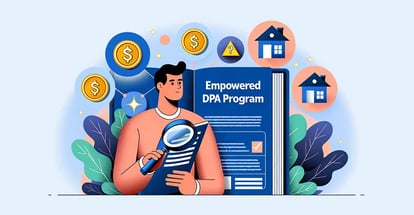First Time Home Buyer Process in Florida: Expert Guide for 2025
What does "first-time homebuyer" mean?
A first-time homebuyer in Florida might refer to someone who's never bought a home before. But in some cases, the definition is broader.
Homebuyers who don't have a big down payment might qualify for assistance from first-time homebuyer grants and loan programs, even if they've purchased a home before.
Buyers must have not owned a home for at least the past three years to qualify for many of these programs.
Benefits of being a first-time homebuyer in Florida
There are many benefits to being a first-time homebuyer in Florida, not least of which is the state's housing market, which has seen steady appreciation over the past decade, offering significant potential for future wealth creation. (Source: Florida Realtors)
This appreciation in property values is a boon for any investor, particularly those entering the market for the first time.
In addition to the promising market trends, Florida offers tangible financial incentives that make homeownership more attainable and economically beneficial for first-time buyers.
One of the most significant benefits comes from the state's Homestead Exemption, which can slash your property taxes significantly.
According to the Florida Department of Revenue, the Homestead Exemption saves the average homeowner around $583 annually.
This reduction in annual expenses can make a considerable difference in affordability for first-time homebuyers, easing the financial burden of homeownership.
Moreover, first-time homebuyers in Florida can take advantage of the Mortgage Credit Certificate (MCC) program, which offers a chance to save even more.
The MCC can save homeowners up to $2,000 annually on their federal taxes, which could add up to $20,000 over 10 years, as reported by the Florida Housing Finance Corporation.
This double dip into tax savings enhances the appeal of buying a home in Florida, making it an even wiser financial decision.
Beyond these specific financial incentives, many lenders offer slightly discounted mortgage rates to first-time buyers, and numerous state and local government programs provide down payment assistance or other types of aid.
These programs are designed to make buying a home more affordable, although it's important to note that some may have specific requirements, such as income limits, while others may not impose any restrictions.

Home-buying market outlook for Florida in 2024
The home-buying market outlook for Florida in 2024 has several key indicators suggesting a stable yet modestly growing environment for buyers and sellers.
Median sale prices are expected to increase marginally by 1-3%, with anticipated values reaching around $410,000 to $415,000, according to projections from Houzeo and Florida Realtors. This modest increase reflects a balanced market that continues to attract a diverse range of buyers.
The inventory situation remains tight, with the months of supply hovering around a low four months, indicating a seller's market where demand outpaces supply, as reported by Houzeo.
Mortgage rates, a critical factor influencing buyer sentiment and affordability, are predicted to stabilize in the latter half of 2024, as per Bankrate. This stabilization is expected to bring more buyers back to the market, making homeownership more accessible to a broader audience.
Home sales are anticipated to show moderate growth, with a potential increase of 2-5% compared to 2023, suggesting a resilient market that continues to recover and grow, as noted by The Mortgage Reports.
The share of first-time homebuyers is projected to remain steady at around 30% in 2024, supported by continued assistance from down payment aid programs, highlighting the ongoing efforts by the Florida Housing Finance Corporation to make homeownership attainable for newcomers to the market.
Meanwhile, the luxury market, particularly in high-demand areas like Miami and Tampa Bay, may experience slower growth than the previous year, indicating a possible cooling in the most expensive segments of the market, as per Florida Realtors.
Foreclosure rates are expected to see a minimal increase. Still, according to CoreLogic, they will remain well below pre-pandemic levels, a sign of the overall health and stability of the housing market.
On the other hand, the rental market is predicted to see rental prices continue to rise, potentially outpacing home price growth due to the tight inventory, as suggested by Zumper. This could further emphasize the attractiveness of buying over renting for those able to enter the housing market.
Additionally, Florida's population is projected to grow by 1.8% in 2024, as per the University of Florida, fueling continued demand for housing across the state.
Step-by-step first-time homebuyer guide
Table of Contents
- Step 1 - Assess your finances
- Step 2 - Decide which type of mortgage to get
- Step 3 - Get quotes from at least three mortgage lenders
- Step 4 - Get preapproved for a mortgage
- Step 5 - Find a real estate agent
- Step 6 - Shop for your home
- Step 7 - Be prepared to make an offer
- Step 8 - Negotiate closing costs
- Step 9 - Hire a home inspector
- Step 10 - Get homeowners insurance, finalize your move and close
Step 1 - Assess your finances
Before buying a home in Florida, reviewing your finances to ensure you're prepared for the costs associated with homeownership.
Here are some key things to consider:
Credit
Checking your credit reports and scores is crucial. A higher credit score can lead to more favorable loan terms, saving you money over the life of your mortgage.
While you can still get a loan with a score as low as 500 (for an FHA loan) or 620 (for a conventional loan), a score of 760 or higher will generally qualify you for the lowest rates and most favorable terms.
Debt-to-Income Ratio
Your debt-to-income (DTI) ratio is another important factor to consider. This ratio compares your monthly debt payments to your gross monthly income.
For housing costs, including mortgage payments, property taxes, homeowners insurance, and homeowners association dues, the ideal spend is 28 percent of your gross monthly income.
For all monthly debt payments, including housing costs, the ideal spend is 36 percent. Many mortgage lenders prefer a DTI ratio of no more than 43 percent, but some may go up to 50 percent.
Remember that the higher your DTI ratio, the more likely you are to pay a higher interest rate on your mortgage because you're considered a riskier borrower. Additionally, a higher DTI ratio can put a strain on your finances.
Down Payment
The next important factor to consider is the down payment.
If you are interested in a conventional loan and can afford to put 20% down, you can avoid paying private mortgage insurance (PMI), which protects the lender if you default.
However, you can still get a conventional loan with as little as 3% or 5% down, depending on the loan type, with the added cost of PMI. VA and USDA loans do not require any down payment, while FHA loans require a minimum of 3.5% down.
Savings
After assessing the down payment, you should also evaluate your ability to pay for closing costs, which usually range from 2% to 5% of the home’s purchase price.
Depending on the fees charged by your lender, you may need to set aside a significant amount of money for the closing day.
You must also consider the earnest money deposit, a smaller deposit submitted with your initial offer to buy a home. The deposit required varies by state, with some asking for 10% of the home's purchase price and others accepting a few hundred dollars.
In addition to all these costs, you should have some cash set aside for moving expenses, furniture, and potential repairs or updates you may want to make before moving in. It is essential to have funds reserved for emergencies, too.
Once you have evaluated these factors and determined what you can afford, gather your financial information, such as pay stubs, bank statements from the past two months, W-2 forms, federal tax returns from the past two years, and any other information related to your assets and debt.
This information will help your lender determine your eligibility for a loan.
Step 2 - Decide which type of mortgage to get
When looking into mortgages, there are various types to consider. The first factor to contemplate is choosing a fixed-rate or adjustable-rate mortgage (ARM).
Fixed-rate loans have a slightly higher rate than ARMs, but the interest rate remains constant throughout the mortgage term, allowing you to know your monthly payments in advance.
On the other hand, ARMs start with a lower rate for a set period (e.g., five or seven years), and then the interest rate changes at a predetermined interval (e.g., once a year). If the rate increases, your monthly payment will increase as well.
Loan Term
Another critical factor to consider is the mortgage term, such as 15 or 30 years. Shorter-term loans typically have lower rates but higher monthly payments.
While less budget flexibility might be required each month, it translates to less interest paid over the mortgage life. Ultimately, you need to decide what is more important to you: lower monthly costs or long-term savings.
Most first-time homebuyers usually select a 30-year fixed-rate mortgage. However, for those who don't plan on residing in a property for an extended period, an ARM can help save money. Fixed-rate loans provide stability to those who intend to remain in one location.
Loan Programs
Several loan programs are available, including conventional and FHA loans.
You might not be eligible for some programs unless specific criteria are met, so reviewing the exact terms is essential to determine which suits you.
Step 3 - Get quotes from at least three mortgage lenders
Obtaining rate quotes from several lenders is a helpful initial step in comparing loan offers. Mortgage rates change frequently and can vary significantly among lenders, so obtaining rate quotes from a minimum of three lenders is recommended.
Many lenders offer rate quotes at no cost through their websites if you supply essential information, such as the loan amount, down payment, and credit score range.
In general, securing the lowest interest rate possible is desirable because this will result in lower monthly payments and less overall expenditure.
If this is your first time buying a house, you may want to learn more about how rates fluctuate and the current rate environment to know what to anticipate when requesting a quote. You can know the best time to secure a mortgage by subscribing to a daily rate trends service.
Additionally, working with a mortgage broker who can compare for you may be a good option. Mortgage brokers usually do not charge borrowers a fee for their services.
Remember that while rate quotes are beneficial for comparison purposes, your rate will not be finalized until you secure it with the lender.
Step 4 - Get preapproved for a mortgage
Once you’ve received quotes from several lenders, it’s time to apply for a mortgage pre-approval. A pre-approval is a preliminary commitment from a lender that states the amount of money they are willing to loan you, but it is not a final offer.
Getting pre-approved before beginning your home search is essential because sellers will not consider your offer unless they know you have financing lined up.
The preapproval letter typically specifies the loan program you’re using, how much you’re qualified to borrow, and the expected down payment.
When you apply for preapproval, your mortgage lender will scrutinize every aspect of your financial life, so organizing the necessary paperwork ahead of time is crucial.
Make sure you’re obtaining a preapproval, not a prequalification. While a prequalification can estimate the mortgage amount you could be approved for, it is not a firm commitment from the lender and should not be used to make an offer on a home.
Step 5 - Find a real estate agent
An agent specializing in the local housing market can be an invaluable resource when buying a home. They can provide insights into neighborhoods, school districts, and other factors influencing your decision.
If you’re unsure how to find an agent, ask friends or family for recommendations. Many agents work on referrals, which is a good way to find a reliable agent. You can also research agents online, looking for highly rated agents with positive reviews from past clients.
When considering an agent, it’s a good idea to interview at least three buyer’s agents. Ask about their experience, track record, and whether they specialize in particular areas. Ask for references to verify their experience with past clients.
In a competitive market, it’s important to have an agent who can move quickly on a home you’re interested in and help you navigate a bidding war, if necessary. Talk to your agent about their communication style and how they’ve helped other buyers in the current market.
When you’re ready to look at homes, enlist your agent to help you find the right one and negotiate the best price.
You’ll likely need to sign an agreement with the agent, but you won’t have to pay the agent’s commission — this is paid by the seller, who also pays the agent representing them in the transaction.
Step 6 - Shop for your home
Discussing your budget and priorities with your agent is an enjoyable aspect of the home-buying process.
It's crucial to communicate these details to avoid wasting time looking at unsuitable properties. It's best to visit the homes in person whenever possible rather than relying solely on online descriptions and photographs.
During property showings, take the opportunity to tour the home and the surrounding neighborhood. Consider how you would feel if you discovered the area had a high traffic volume, was located near an airport, or was underperforming schools.
Remember, the property's location can be just as crucial as the home itself. If the home is part of a homeowner's association, request a copy of the HOA documents to review the rules and fees.
Step 7 - Be prepared to make an offer
If you’re interested in a particular home and think it fits your budget and preferences, acting quickly and making an offer is essential.
To determine a fair offer, your agent can analyze recent comparable home sales in the area ("comps") and assist you in making a competitive bid.
Your offer should include an offer price, a deadline for the seller to respond, and any contingencies you want to request.
At a minimum, appraisal and home inspection contingencies should be included, meaning that you can back out of the deal and keep your deposit if the home appraises for less than the offered price or if the inspection uncovers significant issues.
If there is a chance of a bidding war, you should also add an escalation clause that establishes a maximum offer limit.
While some buyers choose to waive contingencies to make their offers more appealing, this should be avoided. Purchasing a home only to discover later that it has significant problems beyond your budget can be disastrous.
However, in highly competitive markets, purchasing a home with specific contingencies may be challenging. Speak with your realtor to determine what is feasible.
Prepare to negotiate the price
When you submit a purchase agreement to the seller, they may accept, reject, or propose a different price. Utilize your agent’s expertise to bargain with the seller for the most advantageous result.
If you compete with other offers in a bidding war, consider writing a letter to the seller conveying your admiration for the home.
However, don't be disheartened if you lose to another buyer. In today’s market, where many homes sell promptly and above the listed price, it's entirely possible that you may not secure the first home you make an offer on.
Step 8 - Negotiate closing costs
After accepting your offer, the next step is to apply for a mortgage. Once you've applied, your lender will send you a loan estimate within three days that outlines the terms of the loan and the estimated closing costs.
Some closing costs can be negotiated, such as origination and underwriting fees, that may be waived or discounted upon request.
Alternatively, you may opt for a no-closing-cost option that adds these fees to your loan but comes with a higher interest rate. Make sure to ask your lender about any fees that you don't understand.
If you need help covering closing costs, consider looking into the down payment and closing cost assistance programs offered by your state's housing finance agency or local housing organizations. You may be eligible to receive several thousand dollars to help with expenses if you meet program requirements.
Paying mortgage points
Another factor to consider is whether you should pay for mortgage points to lower your mortgage rate. Essentially, paying points means you're prepaying some of the interest on your loan.
Typically, each point costs 1% of the total value of your loan. So, for a $250,000 mortgage, buying one point would cost $2,500, and each point you pay generally lowers the rate by 0.25%.
Generally, it's better to pay for points if you plan to stay in a home for a longer time, as you'll recover the cost of the points through a lower monthly payment on your loan.
To determine the breakeven point, divide the amount you pay for a point by the amount you'll reduce your mortgage payment each month.
For example, if you pay $2,500 for one point, and that lowers your monthly payment by $30, you would need to live in the home for about 84 months (or approximately seven years) to break even ($2,500 divided by $30).
Step 9 - Hire a home inspector
Once your offer has been accepted, hiring a home inspector to evaluate the property is crucial.
Your agent can recommend a reliable inspector, or you can search for one through reputable organizations like the American Society of Home Inspectors, the International Association of Certified Home Inspectors, and the National Academy of Building Inspection Engineers.
As with researching agents, it's important to consult online resources such as the Better Business Bureau, HomeAdvisor, and Yelp to read testimonials and check for complaints.
During the inspection, the inspector will examine the home's structure, roof, heating, plumbing, and electrical systems. Still, it's important to note that they typically won't check for lead paint or mold.
The inspection can take two to three hours and may cost between $300 to $1,000, depending on the home's size and the inspection's extent.
It's recommended that you and your agent attend the inspection so that you can ask questions and seek clarification on any issues that arise. After you receive the inspection report, review it carefully with your agent and determine your next steps.
If the inspection reveals major problems, you could request that the seller fix them, but they may not be willing to do so if other offers don't require repairs.
If you have an inspection contingency in your purchase agreement and the seller is unwilling to address the issues, you may leave the deal.
Step 10 - Get homeowners insurance, finalize your move, and close
To safeguard their investment, mortgage lenders mandate that homeowners have insurance.
The premiums charged by insurance companies may differ, hence it is wise to obtain quotes from multiple firms or hire an insurance broker to obtain rates on your behalf.
It is crucial to evaluate your requirements and ensure that you purchase sufficient coverage to fully reconstruct your home in the event of severe damage or destruction. If your property is in a federally designated flood zone, you must also purchase flood insurance.
Organize your move
Depending on your desired moving timeline, it is wise to begin planning your move before the closing date.
Before you move in, contact your utility, cable, and internet providers to arrange a new service for your move-in date. Then, hire a reputable moving company and begin packing your belongings.
Attend the closing
Finally, it is time to close the deal and finalize the purchase contract to become a homeowner officially. Before the closing, obtain updated pay stubs and other financial documentation to prove your employment status and ability to make mortgage payments.
If you are paying closing costs on the day of the closing, obtain a cashier’s or certified check made out to the escrow company for the funds in advance. Don’t forget to bring your identification as well.
Within 24 hours of the closing, conduct a final walkthrough of the property to ensure that any repairs have been made and the home is vacant.
At the closing table, you will sign a lot of paperwork to finalize the loan and transfer home ownership from the seller to you.
What lies ahead for those who have recently become homeowners?
Once you’ve bought your home, there are still important things to consider. First, look at your property and decide what improvements or repairs you want, using the inspection report as a guide.
It’s a good idea to start saving money in a home improvement fund for these projects and unexpected repairs.
Keep an eye on the housing market and mortgage rates as time passes. If home values are increasing, you may consider tapping into your home’s equity through a cash-out refinance, home equity line of credit (HELOC), or home equity loan.
If interest rates have fallen, refinancing to a lower rate may save you money, but weigh the pros and cons of each option.
If you choose to prepay your mortgage or make extra payments, speak to your lender first to ensure the extra payments go toward the principal balance, not just the interest.
Consider your goals and other financial moves you could make before focusing on a payoff.
With over 50 years of mortgage industry experience, we are here to help you achieve the American dream of owning a home. We strive to provide the best education before, during, and after you buy a home. Our advice is based on experience with Phil Ganz and Team closing over One billion dollars and helping countless families.

About Author - Phil Ganz
Phil Ganz has over 20+ years of experience in the residential financing space. With over a billion dollars of funded loans, Phil helps homebuyers configure the perfect mortgage plan. Whether it's your first home, a complex multiple-property purchase, or anything in between, Phil has the experience to help you achieve your goals.


 By
By  Edited by
Edited by 






